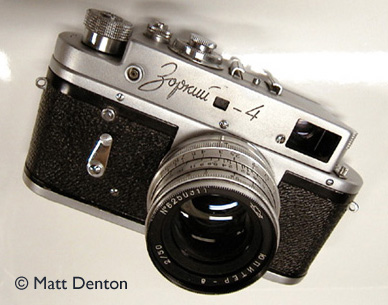- Produced 1956-73 (1962) KMZ, Krasnogorsk (Moscow), Russia
- Film type 135 (35mm)
- Picture size 24 x 36mm
- Weight 25.6oz (725.8g) with Jupiter-8 (white)
- Lens LTM Jupiter-8 (KMZ copy of Zeiss Sonnar) 50mm 1:2-22
- Filter size 40.5mm threaded, 42mm slip-on
- Focal range 1m to infinity
- Viewfinder coupled rangefinder
- Exposure meter none
- Shutter double cloth curtain
- Shutter speeds B, 1s-1/1000
- Diopter correction lever
- Self-timer
- Accessory shoe and PC sync connection
Overview
This a real classic camera, the KMZ copy of the Leica II and the one where they got it (just about) right. It will in fact mount actual Leica L-mount lenses if you have any…but the Jupiter-8 is about as good as they come so why bother I say? It’s very smooth to focus, though the lack of detents (click-stops) on the aperture wheel makes it easy to accidentally change the f-stop while focusing. By the way if you do use other lenses, say with different focal lengths, you’ll need to pick up one of those crazy auxiliary turret viewfinders — the built-in viewfinder is of course strictly fixed for 50mm.
Overall it’s got a great feel – nicely compact and balanced, but the cloth shutter is surprisingly loud considering it’s made of silk, especially compared to the whisper-quiet metal curtain in the Kiev 4, but smooth and pretty accurate for a 40-year old camera. Let’s just say it’s a lively ‘snap’ sound. Snap! One of my favorite and least favorite parts of the camera is a little diopter adjustment lever which is nice to have but easy to get stuck fiddling with if you know what I mean.
It’s a very enjoyable user, with its large bright finder, rounded sides and comfortable vulcanite exterior, smooth, snappy shutter and sharp lens. It’s all good. My ONLY complaint is something that actually got corrected in the next model: the knurled wind knob is hard on the fingers. If you want a Zorki 4 with the advantage of rapid-wind then go for the 4K. They’re not as handsome because they were later, cheaper models with ribbed cloth coating, but they do have that modern wind lever. The rest of the camera is largely the same, except that the ‘white’ Jupiter-8 gets replaced with a black Jupiter-8 (late model, plastic housing). Also not as handsome IMO, but I’m sure it’s just as sharp.
Repairs
Apart from needing a light cleaning it’s in excellent shape for its age. However, I did think the aperture ring was a bit too easy to turn, it kept moving on its own when I wasn’t looking. So, working in a tray, I carefully took out the 3 tiny set screws in the aperture ring, and screwed the ring down to reveal 2 more set screws, which once removed allowed me to unscrew the front element housing. I took out the front element and the spacer (I do this by turning the camera over and letting the element(s) fall into a clean photowipe in my other hand) to get access to the moving parts. To make the ring move more slowly I put some moly grease in with a Q-tip. (Note: if I were trying to make it move easier I would have used synthetic grease.). Now it stays where I put it! You could probably do the same without going that far, just unscrew the outer aperture ring and squish a little grease in between the inner ring and the lens barrel.
Tips & Tricks
Rule one this time isn’t ‘take off the lens cap’, it’s ALWAYS cock the shutter before changing film speeds! It’s in the manual but it bears repeating. In fact, go read the manual before even attempting to use the camera, the stuff about shutter speeds is both non-intuitive and critical to the proper operation of the camera. Changing film speeds without tensioning the shutter can damage the shutter! (This is apparently true of any camera where winding on also causes the film speed selector to turn, eg they are coupled.)
Rule two is of course remove the lens cap! Now, I’m a big proponent of using not only lens caps but UV filters for protection, especially when you have an old valuable lens like the Jupiter-8. Luckily 40.5mm is a current if not common size; it’s used on movie cameras
I’ll throw in a bonus Rule three – don’t lose the takeup spool, it’s not attached and falls out without warning. This also was fixed (heh) in the 4K. You can make another but ‘an ounce of prevention’ and all that…
Here’s something it took me a while to notice – the tripod mount is not the standard 1/4″ mount, but the European 3/8″ mount that requires an adapter, which I’ve been lucky enough to find. Otherwise it’s handhold-only, you Henri wanna-bees!
Related Links
- The very important OWNER’S MANUAL – please commit it to memory
- Part of Alfred’s wonderful Camera Page is an homage to the Zorki-4
- A page devoted to Russian Rangefinders
- And a nice page on ‘Why Russian Leica Copies?’ Well, because!
- If you lose the takeup spool or get one without, Mike Elek has an easy way to make a replacement

